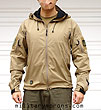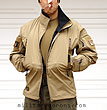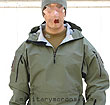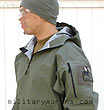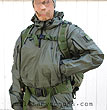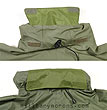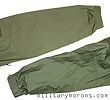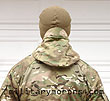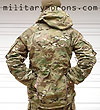Military Clothing (Non Uniform) Page
1 2
3
4 5
6 8 9
This section features Military clothing that are not uniforms/BDUs.
As a sizing reference: I'm 5'7", 155 lbs (yeah, I'm a little guy), medium build (BDU top medium/regular, BDU pant medium/short), waist 32", chest 43". Keep this in mind when you read my comments with respect to sizing, so you have an idea of how the garments featured below will fit on you. ALL garments in these pages are size Medium, unless stated otherwise.
TO VIEW FULL SIZE IMAGES: USERNAME and PASSWORD are both "mm"
TAD Gear Stealth Hoodie SS v3.0 and Stealth Jacket
| 2/9/08 - Triple Aught Design's (TAD Gear) Stealth Hoodie SS v3.0 and Stealth Jacket v3.0 are the next generation of their successful Gen 1 and 2 Stealth Hoodie Soft Shells covered here. The only difference between the Hoodie and the Jacket is that the Jacket lacks a hood, having a stand-up collar instead. With water resistance approaching that of a hard shell, but having the stretchiness and breathability of a soft shell, the new v3.0 Stealth Hoodie and Jacket end up somewhere in-between - a hybrid of sorts, further blurring the line between hard and soft shell. Shark Skin Material - In comparison to the Gen/Version 1and 2 Stealth Hoodies, the first thing I noticed about the v3.0 was that the material was lighter and thinner. The v3.0 uses TAD's new "Shark Skin Soft shell" material, which is a 4-season, 3-layer laminate. Instead of the textured outer shell like the v2, the Shark Skin outer shell has a very fine weave. It's not as thick or stiff, but very soft and supple, and also stretches. The smoother weave also makes it slightly quieter. The DWR-treated outer shell is bonded to a waterproof-breathable membrane middle later, with a wicking Coolmax inner facing. TAD claims that this is one of the "toughest, most water-resistant and breathable soft shell fabrics available." I can't vouch for the toughness yet, but it really is VERY water-resistant and also seems to be quite breathable. It's also completely wind resistant. When I first handled the jacket, I was a bit surprised that the material was as lightweight as it is, and it wasn't 'heavier'. Typically, I've come to expect soft shells to be somewhat stretchy material with a low-loft fleece or brushed inner face to provide some insulation. So, when this lightweight jacket came, I was expecting something more 'substantial'. However, after wearing the v3.0 Hoodie and Jacket around for a while, I've come to appreciate the route that TAD took with this material. It all lies with what you want from a soft shell jacket - a jacket that provides some warmth and protection against rain and wind, or more of a layering shell over an insulated base layer. It's more convenient to have a jacket that does double duty, but layering allows more versatility over a wider range of temperatures. The v3.0 also compresses into approximately half the size the previous versions did. TAD intended the v3.0 to be a 4-season soft shell that could also be worn in the summer during thundershowers, sprinkles or tropical areas of operation. Soft shells are not waterproof; they sacrifice absolute waterproofness for comfort and breathability. In heavy rain, it's not unusual for a soft shell to let some water through to the inner layer and get it damp. The more heavily insulated the jacket material is, the longer it takes to dry when wet through. A lighter shell will dry quicker, and also give the user a chance to change to a dry base layer.
Stealth Hoodie SS v3.0
- The only difference between the v3.0 Stealth Hoodie and Jacket is
that the Hoodie has an attached hood, with TAD's familiar Aero design
(more on the hood later). All other features are common to both the
Hoodie and Jacket.
Stealth Jacket SS v3.0 - The Stealth Jacket is the hood less twin to the Hoodie, for those who don't feel the need for or like an attached hood. The stand-up collar is 3" tall at the front and 2.6" tall in the back. There's a chin guard behind the zipper in the front.
Here's a summary of the features on the Stealth Hoodie and Jacket SS v3.0. Unless otherwise mentioned, all of them are common to both jackets:
Soft shells on the market range from the single-layer PCU L5 shell, to the insulated SORD Hardface jacket. The v3.0 Stealth Hoodie SS and Jacket fall somewhere in between the two; more towards the lightweight side. The addition of a waterproof breathable membrane puts the v3.0 close to hard shell territory, except that the seams aren't sealed. The v3.0, however, is much quieter and less 'crinkly' than a hardshell - also more comfortable because of its breathability and stretch. As I mentioned before, I was fooled by the lightness of the Shark Skin fabric into thinking it was 'cheaper' and somehow less 'substantial'. How wrong I was. The more I wear the v3.0, the more I prefer it to the previous versions, which were also great jackets. The v3.0 just kicks the previous versions' asses in water-resistance while still remaining very comfortable with its stretchy fabric. It also retained heat better than I expected, for its thickness, when the pit zips and main zipper were closed. The Coolmax inner layer contributes a lot to its comfort - providing both light insulation and moisture transport/wicking away from the skin. TAD designed the v3.0 as a 4-season shell, which can be used in warmer weather and climates as a stand-alone soft shell, or a highly water and wind resistant outer shell over an insulating layer in colder weather. They've done their job, from the looks of it. In my opinion, this is the best Stealth Hoodie version to date.
|
TAD Gear Combat and Bug Out Anorak Hardshells
| 4/23/08 - Triple Aught Design (TAD Gear) has introduced two new hardshell jackets, the Combat Anorak and Bug Out Anorak Hardshells. The Combat Anorak was designed to be the most abrasion-resistant hardshell available, that would stand up to just about anything you could throw at it. The Bug Out Anorak was designed to provide protection from the elements in a more compactable package for stowing. They're essentially Anorak versions of the Predator Hardshell, and share many of the same features. An Anorak is typically described as a hooded pullover garment instead of having a full front zipper. I used to wear them when I was a kid in England. The word 'Anorak' has its origins in Eskimo-Aleut language. Now, why offer an Anorak design? I asked Patrick at TAD to shed some light on this latest direction in TAD's hardshell offerings and he replied: "The traditional reasoning behind an anorak versus full zips were that anoraks are typically to be worn for long periods of time and would provide the user with better overall protection by virtue of “less zipper”. This translated to “fewer possible points of entry for snow, wind and rain”. Also, less zipper = less weight/bulk. Without a full zipper, there are no hot spots and friction points on the body when wearing a pack waist belt. In fact some old classic designs had the Kangaroo pocket big enough to allow the belt to pass entirely thru on the inside. The Kangaroo pocket also allowed for both hands to be put together to keep warm. In high altitude alpine conditions, a shell would be worn all day; mountaineering, skiing, etc. Professional dogsledders, European mountain/ski troops, arctic explorers still use the anorak design. The TAD Combat anorak design is tasked for those kinds of environments where a shell would be worn all day, into the night and possible even to sleep. The Kevlar blend poly 3 layer found in the combat anorak IS the most abrasion resistant shell available from anyone, it is a tough mofo of a shell. The fabric was developed specifically to resist frequent exposure to rock faces, crampons, ski edges, and “climbing racks” (pitons, anchors such as cams, etc found on a sling). The Bug Out Anorak was a shell I wanted to offer that had less bulk and was more compactable for stowing. All of TAD's hardshells are great overall shells for protection against rain, snow, wind. However each has it’s own specialty and excels in that specialty. Anorak designs are a bit of a throwback, as there is the very compelling convenience of easy on/off with full zip jackets which dominate the market today. But, the virtues of an anorak stand out under certain circumstances, and are enough for me to explore the design this year." So, there you have it from Mr. TAD himself. Other than some small details, the main difference between the Combat and Bug Out Anoraks is the material. Material - The TAD Gear Combat Anorak is constructed of TAD's "Storm Shield EDGE" 3 layer, waterproof/windproof/breathable Kevlar reinforced shell fabric. Going beyond TAD's regular Storm Shield 3 layer fabric, the EDGE version of their high performance, technical material has all the familiar well known benefits of a waterproof-breathable textile, but now has the highest abrasion resistance of any hardshell available on the market, anywhere. Storm Shield EDGE is designed to provide extra protection against the environment, tools and equipment commonly found in alpine and mountaineering arenas that can wreak havoc on typical hardshells. The Combat Anorak is currrently only available in TAD's M.E. (Multi Environment) Green. The shade of green is slightly more olive/darker than either the Predator V1.0 or the Bug Out Anorak. It doesn't have the typical nylon look or feel to it; in fact it reminds me of the oiled canvas Drover coats, only without the oily sheen or feel. It's slightly stiffer than the Predator.
The TAD Gear Bug Out Anorak is constructed out of TADs durable, all-season, light weight "Storm Shield LITE", which is a 3 layer, waterproof/windproof/breathable ripstop nylon shell fabric. Like the EDGE fabric of the Combat Anorak, the Storm Shield LITE version has all the benefits of a waterproof-breathable textile, but is made in a lighter weight modified ripstop pattern. It's probably one of the lightest 3-layer hardshell fabrics I've come across. It is designed to be "durable enough for fast summit assaults to summer thunderheads" and protect the wearer from the elements, but with reduced weight, bulk, and packs down to a compact and portable size. The Bug Out Anorak is also available only in M.E. Green for now. The fabric isn't a solid green colour; there's a pleasing subdued crosshatch pattern to it, with the horizontal lines fainter than the vertical ones. Overall Features The Combat and Bug Out Anoraks share the same features except for the material; the other main difference is that the Combat Anorak has a traditional length bias Alpine cut and is about 2.5" longer than the Bug Out Anorak (which has a modern length bias Alpine cut) in the front and back, and about 3" longer than the Predator so it's more of a traditional length anorak. This is so it covers the loins better when sitting down and much of the seat. The Combat Anorak and Bug Out Anorak have the same overall
fit and cut. In the photos below, the Combat Anorak looks a bit bigger,
but it's due to the stiffness of the fabric. The Bug Out Anorak is
thinner and tends to drape more over the body.
Notes about fit - When you're considering one of these Anoraks vs. a regular full zip jacket like the Predator Hard Shell, the key questions I'd ask are 'what are you going to use it for?' and 'are you planning on wearing it over bulky layers?'. The trade-off for some weight savings and less of an opening to moisture or dirt is on/off convenience. If you're planning on taking it on and off frequently, then a full zip front jacket has the advantage. Wearing anything on your head won't help with the donning or doffing process. I'f you've got a helmet, that probably has to come off. Also, if you're planning on using it as a shell over bulky layers, bear in mind that an Anorak will be more difficult to don and doff. How easy it is to put on and take off depends on how you fit into the Anorak. I'm a medium build and wear a medium Anorak. If I were any bulkier or my shoulders much broader, I'd have some difficulty putting it on, and would probably have to go up a size. Just to try it out, I tried to put on the Combat Anorak over the Ranger Hoodie, which is quick fleece. Much to my wife's amusement, it took me a bit of struggling to get it over my head and shoulders, as the Anorak doesn't stretch. Once I got it on, there was ample room inside the Anorak to accomodate the Ranger Hoodie, but it wasn't easy to put on over it. I had no problems putting both Anoraks over a thinner layer like a sweatshirt. If you have a Predator or similar jacket, leave the front zipped up and see if you can easily put it on my slipping it over your head and shoulders, to get an idea of how the Anoraks might fit over insulative clothing. The Bug Out Anorak is a bit easier to don and doff as the material isn't as stiff as the Combat Anorak and it has a bit of 'give' to it. General Notes - I've worn both in the rain, and they kept me dry, as expected. I was actually surprised how non-stuffy the Combat Anorak feels. Before putting it on, and based on how the material felt, I thought it'd get too hot and stuffy unless it was really chilly, but that wasn't the case. I felt comfortable wearing the Combat Anorak in temperatures where I'd be uncomfortable in my original Goretex Gen I ECWCS parka (upper 60's). The Bug Out Anorak can be used in warmer weather than the Combat Anorak; comfortable up through the mid-70's. TAD designed the Combat Anorak to be "one of the toughest, most abrasion resistant jackets anywhere; a dedicated service hardshell specifically tasked for alpine and mountain environments". The Kevlar reinforced material sure feels tough and is substantial enough to provide some protection against scrapes and knocks, and makes it more comfortable on your elbows and front when in the prone position on uneven ground with stones or little rocks. If you're going to be scrambling around rocks or spending time on your belly in the prone position and you know you're going to be in inclement weather, the Combat Anorak would be the one to get. If you don't need the extra abrasion resistance, and want a lighter weight specialized hardshell that's easier to compress and pack, then the Bug Out would be a good choice. It functions great as a wind or rain shirt over other clothing and it's light enough to carry in a pack, car or bag 'just in case', even if you're not sure it's going to rain.
|
| 9/26/08 - Triple Aught Design (TAD Gear) comes out with new stuff faster than I can keep up. The Battle Hoodie was designed as a cool/cold temperature, arid-desert warfare hooded jacket. It's a specialized jacket, and was produced in response to very specific requests for a quiet, non-melting, insulated garment for dry environments. TAD Gear was asked to design a garment that would be tasked for the colder months at higher altitudes in Afghanistan and Iraq. It had to be no-melt and was to be used in dry/arid environments, so a cotton blend for the outer fabric was chosen. Warmth was desired, so it is fully lined with a cotton liner. The Battle Hoodie is the garment that resulted from this criteria. It's reminiscent of a combat smock, but lined instead of just a shell. It also reminds me somewhat of the old M-65 field jacket, but of a much more modern design and lighter in weight. A non water-resistant, cotton/cotton blend, insulated jacket seems like a narrowly focused garment, given the variety of today's soft and hardshell jackets, and the tendancy towards layering. But when you look at the popularity of similar jackets in the civilian arena (Carhartt cotton duck insulated work jackets come to mind), you realize that it's actually a practical choice for an everyday, cool/cold weather jacket if it's dry and windy. Overall Features
Sizing and fit - From the way it fits, the Battle Hoodie is sized more as a stand-alone jacket than one intended to be worn over additional layers. As a Medium kinda guy at 5' 7" and 155-160 lbs, the Medium size fits me just about perfect with a little bit of room all around, but the added volume of the cotton lining inside doesn't leave room for anything but a thin base layer or short-sleeved t-shirt. I wouldn't wear it with anything bulky underneath. The sleeves are cut longer to prevent the cuffs from creeping up the fore arms when the arms are reached out or up, so they reach down to my fingertips. The bottom of the Battle Hoodie is longer than the Stealth Hoodie, and covers my butt. There are a couple of things which I felt could be improved
when it comes to fit: General Notes - TAD envisioned the Battle Hoodie to be their version of a smock, but more modern and updated. But since it's lined, it feels more like a field jacket, or a smock worn over a comfy sweatshirt (or actually, a flannel pajama top). In other words, warm and comfortable. It's best suited for temperatures 70° and below, in my own estimation. It's definitely not a wet weather jacket, being designed for cool, dry climates. Abrasion resistance and durability will be similar to or better than a set of ripstop BDUs; the lining provides some padding and the elbow and shoulder cordura panels will be very wear resistant in those areas. It's also very wind resistant - I tested this out by going on a chilly, early morning ride on my motorcycle. When the sun goes down and a cool breeze starts blowing, the lined hood is especially welcome. Not normally found on cotton jackets like this are the pit zips, which really do make a difference in ventilation. Some might argue that pit zips are necessary only for less breathable garments like hardshells and some soft shells, but I like having the ability to vent a large amount of warm air without having to open the main zipper or rely 'breathability'. The Battle Hoodie functions well as a casual jacket (in the solid colours, if the MultiCam is a bit much for around the town wear) for everyday use in cool and dry weather, and can take the place of a heavy sweatshirt while providing wind resistance and of course, more utility with all its pockets. It can also be considered a field jacket or insulated smock. For a seemingly niche product designed for a narrow task (in the military or contractor role), I think that it's a pretty versatile jacket well suited for general purpose, everyday casual outerwear. The fact that it's a damn good-looking jacket doesn't hurt either.
|
ATTENTION! PLEASE DO NOT LINK DIRECTLY TO MY IMAGES
-
IT RESULTS IN MY BANDWIDTH ALLOCATIONS BEING EXCEEDED,
AND MY PAGES GO DOWN. THANKS!
/ . PLEASE
OBSERVE AND RESPECT OUR COPYRIGHT! . /
©opyright by MilitaryMorons.com. All Rights Reserved. Reproduction, Duplication,
Distribution Strictly Prohibited.
Unless mentioned otherwise, content and images are the
property of militarymorons.com and are not in the public domain.
They are not to be used without
permission. Please Contact
me for permission to use any images or content herein.

